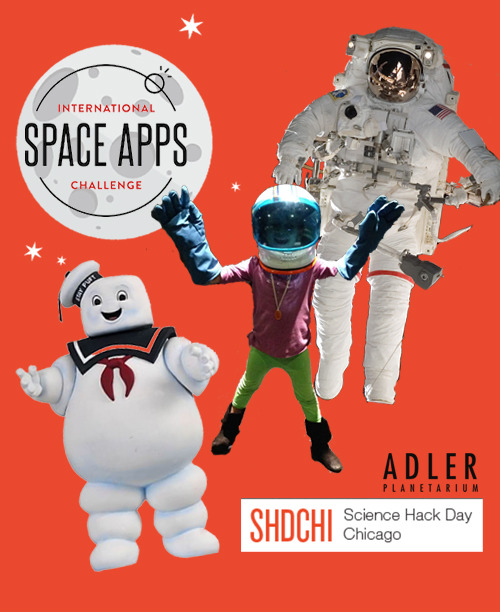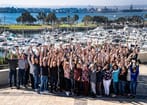While there were no Grubhubs-for-the-Moon or Sittercities-for-Mars at this hackathon, there were some rather amazing out-of-this-world ideas, including a few with some potential here on Earth.
Science Hack Day (SHD) at the Adler Planetarium is a hoot. Two years ago, I was thoroughly charmed at demo day watching teams—who had spent the night at the museum—present a series of delightfully and often literally "out there" ideas. "Galaxy Karaoke" and "Quantum Foam" anyone? How about an app to calculate that pesky space-time jet lag for those really long flights? It's an Einstein-inspired must-have. Or how about a brain wave-operated video game?
I couldn't make it last year, but when an email announcement wafted into my inbox this year, I cleared the calendar. This time I wanted to be part of a team and was no longer intimidated by the sad fact that I am not a very good coder (sorry Starter League—more my fault than yours). Instead, I could offer words. What startup couldn't use a few good words?
Since 2010, there have been dozens of Science Hack Days held all over the world. This time for extra fun, the Chicago SHD was run concurrently with the International Space Apps Challenge.
Some teams came ready-made, knowing exactly what they wanted to build, though most people were like me: clueless but willing. Remarkably, not only did groups gel around projects by early afternoon, but the work quickly become so riveting, it took coaxing to get us all to take a break on Sunday morning to go see a free planetarium show. It turns out that if you want to think outside the box, it really helps to see beyond the planet. A quick jaunt through the solar system, through the Milky Way, past billions of galaxies to the edge of the known universe clears out all manner of cognitive cobweb. "Shoot for the stars" is just good advice.
I joined Team Sentio, working on a Space Apps project for the Space Wearables: Fashion Designer to Astronauts challenge. Cosmic style absolutely counts, but we took things a bit deeper, reimagining the space suit in terms both of form and of function.
There were four of us: Kent, a proud member of The Mars Society and veteran of Mars Desert Reseach Station who has thought deeply about what it would take to live and work far from our lovely "pale blue dot" planet. Alex, an extraordinarily creative thinker whose annual visits to the Burning Man Festival have reinforced his rather boundary-stretching ideas about perception. Julieta, whose impressive official title—Associate Director, Space Visualization Laboratory, Adler Planetarium—only scratches the surface of a deep interest in senses and sense-making. For my part, I tried to keep up with on-the-fly research, pulling up articles and papers on everything from lateral lines in fish to the impact of toolmaking on the evolution of the human hand. We also had a team mascot: six year-old Maia—by far the cutest one in the picture above.
RETHINKING THE SPACE SUIT
The modern space suit can make even the fittest astronaut look like the Stay Puft Marshmallow Man. It is a cocoon designed for disaster, keeping out radiation, regulating body temperature, supplying oxygen, facilitating what is delicately referred to as “astronaut hygiene” and protecting against the occasional ping of a stray micrometeorite. All of this, of course, is essential, but it hobbles an astronaut from the main mission: exploration.
We wouldn't think of sending lovely Maia out to explore her neighborhood sealed in a bulky helmet and gloves, yet this is exactly what we have done to astronauts trying to explore the cosmic neighborhood. Our senses tell us everything from whether the sky is cloudy or clear, humid or dry, hot or cold, raining or snowing, day or night. But put on a space suit and suddenly the steady flood of information we take for granted is either muffled or gone. It is hard to walk, turn one’s head, kneel down to take a closer look or even pick things up. Even sight, the one sense that as Julieta points out allows us access to the heavens from earth, is restricted to a much reduced narrow field of view.
The team wondered whether there might be a way to redesign the space suit so instead of limiting perception, it increases it. We came up with Sentio, a spacesuit that not only reinstates senses rendered useless in space, but then goes a step beyond, augmenting and extending them for applications that haven't been needed here on Earth.
There are two parts to the design: physical and sensor-based. We started by rethinking the glove, which meant reexamining the hand:
The hand is where the mind meets the world. We humans use our hands to build fires and sew quilts, to steer airplanes, to write, dig, remove tumors, pull a rabbit out of a hat. The human brain, with its open-ended creativity, may be the thing that makes our species unique. But without hands, all the grand ideas we concoct would come to nothing but a very long to-do list...
Darwin was the first to speculate that toolmaking could have played role in developing the shape of the human hand, which is unique among primates and, indeed, unique among all species. It turns out he was right. Our destiny has literally always been in our hands. Yet while human hands are exquisitely adapted to life on Earth, new hands with new abilities will likely be required for life beyond our planet. For that, evolution will need a jumpstart.
The Sentio suit glove has two parts: a control panel for the hand itself and a series of snap-on extensions for whatever task needs to be done. Why try to grasp a drill when you can be the drill? For that matter, why stop at hands? Boots can be redesigned for climbing and a prehensile tail added for better balance and grasping. We have an ark-full of nature's designs all around us for inspiration. (Bio)mimicry is simply the highest form of flattery.
Organisms capable of changing form turns out to be more the rule than the exception. Many species, from butterflies to frogs, undergo radical transformation from one stage of life to another to adapt to different environments and needs. Although a caterpillar may be well-suited for nibbling milkweed plants, if a Monarch has any hope of flying to Mexico for the winter, it can only do so as a butterfly. Likewise, humans flying to other worlds would be well-served to add shape-shifting to the tool kit.
The Sentio suit is also fitted out with sensors. A sensor on the outside of the glove, for example, could be coupled to pressure-triggering mechanism on the inside, turning the glove into a kind of second skin. Likewise, a sensor placed on a drill bit module could be coupled with a sensor in the glove control panel, providing an astronaut with a physical, real-time intuitive sense of the drill bit's temperature.
An astronaut also could be sensorially attached to a series of little rovers (Kent dubbed them "goslings"), instantly increasing an astronaut's "footprint" beyond the suit.
Senses could also remapped in a sort of synthesia by design. For example, a sensor measuring cosmic rays could be programmed to tighten a wrist band when conditions were dangerous, thus giving physical sensation to an otherwise invisible experience. Solar wind might be turned into sound. This is data visualization blown out for all the senses, turning abstractions into formats that can be more readily and quickly interpreted. Once you start skipping down this path, the possibilities are endless.
Senses could even be shared and empathy engineered. For example, if an astronaut were to get hurt, a sensory signal could be sent out to others on the team who would instantly feel whether the injury involved an arm or a leg, even if their injured colleague couldn't speak.
The Sentio suit is also designed to take better advantage of sight, the one sense that functions in space pretty much as it does on Earth. The surface of the suit is "bedazzled" with a colorful array LEDs that can be programmed communicate identity, state of health, type of work, news of a discovery, danger or just about anything else. This is another example of a taking a cue from nature's playbook. Bioluminescence is a fairly common form of communication, used by everything from fireflies and creatures of the deep to fungi and algae.
Perhaps aliens, at least the science fiction kind we know about, look alien for a reason. Why should the forces of evolution—change over time for the survival of the fittest—stop at the stratosphere?
MORE GOOD IDEAS
Ours, of course, was just one of many ideas floating around the room and after 30 hours of deep thinking and imaginative hacking, it was time to present. Among my favorites:
- A scheme to trick out a dual control kite with Arduino servos to gently steer a very small satellite-connected sensor system from its transport ship to the surface of Mars. This team did a lot of kite-flying on the beach and nearly blew us all away with an ad hoc indoor wind tunnel. The system will tested in May using a weather balloon designed to release its payload at 100,000 feet altitude, which just happens to roughly approximate Martian conditions.
- Planet Lab: A website-in-development designed to help students—and their teachers—learn science. Only one out of every five high school students in the US demonstrates proficiency in science. There are many reasons for this sad state of affairs, including out-of-date textbooks. School districts typically use the same books for the better part of decade, but science moves at an astronomically faster clip. The site connects kids and teachers to leading science organizations and researchers and includes a database of classroom-ready and beyond-the-classroom projects.
- The Wii / Quadcopter / Oculus mashup: Basic research rocks. For no other reason than to demonstrate that they could do it, this team wired a quadcopter drone to a Wii balance board and the drone's camera to an Oculus Rift virtual reality headset. The "pilot" can see a drone's eye view through the headset while operating the drone by shifting weight on the balance board. Quadcopter Quidditch anyone?
••••••••••••••••••••••
A week ago I had no idea I would be interested in any of this. A week ago, I would not have thought that four strangers could come together and engage in such a far-ranging, creative and compelling discussion for hours on end. Or that our brainstorming would cascade into so many different concepts with applications far beyond the range of our mission. Imagine empathically wired teams of emergency first responders or LED baseball caps colorfully registering fan support and disapproval. The rooftops around Wrigley will never be the same.
Rather than the usual narrow hackathon focus on "pain points" (no Grubhubs for the Moon or Sittercities for Mars here), the teams thought big, played with tech and to quote Ariel Waldman, "instigator" of Science Hack Day, learned "to manipulate science as just another material." This is what thinking different is all about and it is pretty wonderful. Just take the first star on the left, then straight on 'til dawn. Magic every time.
— J. A. Ginsburg / @TrackerNews / originally posted on Dot to Dot
RELATED:
• Ariel Waldman on Science Hack Day, San Francisco (video)
[video:https://www.youtube.com/watch?v=Dzb_QCYxi3I]
• Science Hack Day: Basic Brilliance / TrackerNews Dot to Dot / J.A. Ginsburg
• Science Hack Day 2014 / Sentio Space Hack by Kent Nebergall / Video by Julieta Aguilera
[video:https://www.youtube.com/watch?v=5uAjIwghAvY]
• Can Robots Be Created with a Sixth Sense?
• Lateral Line Helps Fish Determine Sound Direction
• Hexagonal plate skin gives robots sense of touch
• Scientific papers related to Hex-O-Skin
• World Cup 2014: Paraplegics Will Walk Independently in Mind-Controlled Robotic Suits
• Think Different / Apple ad (video)
[video:https://www.youtube.com/watch?v=Rzu6zeLSWq8]






